Measuring and Visualizing Solar UV for a Wide Range of Atmospheric Conditions on Hawai’i Island
Abstract
:1. Introduction
1.1. Health Effects of UVR
1.2. The Ultraviolet Index (UVI)
2. Instrumentation
3. Methodology
4. Results and Discussion
4.1. Mannequin Head Results
4.2. UVI Measurement Challenges
4.2.1. Ozone Error
4.2.2. Cosine Error
4.3. UVR and Volcanic Sulfur Dioxide
4.4. UVR during Major Smoke Event at MLO
4.5. Photography
5. Conclusions
Author Contributions
Funding
Acknowledgments
Conflicts of Interest
References
- USDA UV-B Monitoring and Research Program, Colorado State University 2018. Available online: https://uvb.nrel.colostate.edu/UVB/index.jsf (accessed on 9 December 2018).
- Nullet, D.; Juvik, J.O. Measured Altitudinal Profiles of UV-B Irradiance in Hawai’i. Phys. Geogr. 1997, 18, 335–345. [Google Scholar] [CrossRef]
- Grainger, R.G.; Basher, R.E.; McKenzie, R.L. UV-B Robertson-Berger characterization and field calibration. App. Opt. 1993, 32, 343–349. [Google Scholar] [CrossRef] [PubMed]
- Voiland, A. Tracking the Kilauea Eruption. In NASA Earth Observatory; 2018. Available online: https://earthobservatory.nasa.gov/blogs/earthmatters/2018/05/14/tracking-the-kilauea-eruption/ (accessed on 9 December 2018).
- Kerr, J.B. Understanding the factors that affect surface ultraviolet radiation. Opt. Eng. 2005, 44, 041002. [Google Scholar] [CrossRef]
- Mims, F.M., III; Frederick, J.E. Cumulus Clouds and UV-B. Nature 1994, 371, 291. [Google Scholar] [CrossRef]
- Moan, J.; Dahlback, A.; Setlow, R.B. Epidemiological support for an hypothesis for melanoma induction indicating a role for UVA radiation. Photochem. Photobiol. 1999, 70, 243–247. [Google Scholar] [CrossRef]
- Grant, W.B. The UVB-vitamin D3-skin pigmentation hypothesis is alive and well. Am. J. Phys. Anthropol. 2016, 61, 752–755. [Google Scholar] [CrossRef]
- Moukayed, M.; Grant, W.B. Molecular link between vitamin D and cancer prevention. Nutrients 2013, 5, 3993–4023. [Google Scholar] [CrossRef] [PubMed]
- Grant, W.B. A multicountry ecological study of cancer incidence rates in 2008 with respect to various risk-modifying factors. Nutrients 2013, 6, 163–189. [Google Scholar] [CrossRef]
- World Health Organization, Ultraviolet Radiation. 2018. Available online: https://www.who.int/uv/sun_protection/en/ (accessed on 2 January 2019).
- Kerr, J.B.; McElroy, C.T.; Tarasick, D.W.; Wardle, D.I. The Canadian Ozone Watch and UV-B Advisory programs. Ozone in the troposphere and stratosphere, Part 2. In Proceedings of the Quadrennial Ozone Symposium, Charlottesville, VR, USA, 4–13 June 1992; Hudson, R.D., Ed.; International Ozone Commission: NASA. Goddard Space Flight Center. 1994; pp. 794–797. Available online: https://ntrs.nasa.gov/search.jsp?R=19950004680 (accessed on 8 December2018).
- Fioletov, V.; Kerr, J.; Fergusson, A. The UV Index: Definition, Distribution and Factors Affecting It. Can. J. Public Health 2010, 101, I5–I9. [Google Scholar]
- World Health Organization. Global Solar Uv Index: A Practical Guide; WHO/SDE/OEH/02.2; World Health Organization: Geneva, Switzerland, 2002. [Google Scholar]
- World Meteorological Organization. Global Atmospheric Watch (GAW): UV Radiation; World Health Organization: Geneva, Switzerland, 2018; Available online: https://www.wmo.int/pages/prog/arep/gaw/UV-radiation.html (accessed on 9 December2018).
- McKinlay, A.F.; Diffey, B.L. A Reference Action Spectrum for Ultraviolet Induced Erythema in Human Skin. CIE J. 1987, 6, 17–22. [Google Scholar]
- Webb, A.R.; Slaper, H.; Koepke, P.; Schmalvieser, A. Know your standard: clarifying the CIE erythema spectrum. Photochem. Photobiol. 2011, 87, 483–486. [Google Scholar] [CrossRef] [PubMed]
- He, H.; Fioletov, V.E.; Tarasick, D.W.; Mathews, T.W.; Long, C. Validation of Environment Canada and NOAA UV Index Forecasts with Brewer Measurements from Canada. J. Appl. Meteorol. Climatol. 2013, 52, 1477–1489. [Google Scholar] [CrossRef]
- Cadet, J.M.; Bencherif, H.; Portafaix, T.; Lamy, K.; Ncongwane, K.; Coetzee, G.J.R.; Wright, C.Y. Comparison of Ground-Based and Satellite-Derived Solar UV Index Levels at Six South African Sites. Int. J. Environ. Res. Public Health 2017, 14, 1384. [Google Scholar] [CrossRef] [PubMed]
- Reichrath, J. Skin cancer prevention and UV-protection: how to avoid vitamin D-deficiency? Br. J. Dermatol. 2009, 161, 54–60. [Google Scholar] [CrossRef]
- McKenzie, R.L.; Lucas, R.M. Reassessing Impacts of Extended Daily Exposure to Low Level Solar UV Radiation. Nat. Sci. Rep. 2018, 8, 13805. [Google Scholar] [CrossRef] [PubMed]
- Gies, P.; van Deventer Green, A.C.; Sinclair, C.; Tinker, R. Review of the Global Solar UV Index 2015 Workshop Report. Health Phys. 2018, 114, 84–90. [Google Scholar] [CrossRef]
- Davis, A.; Deane, G.H.W.; Diffey, B.L. Possible dosimeter for ultraviolet radiation. Nature 1976, 261, 169–170. [Google Scholar] [CrossRef]
- Downs, N.J.; Kimlin, M.G.; Parisi, A.V.; McGrath, J.J. Modelling human facial UV exposure. Rad. Prot. Australas. 2001, 17, 103–109. [Google Scholar]
- Parisi, A.V.; Eley, R.; Downs, N. Determination of the Usage of Shade Structures via a Dosimetry Technique. Photochem. Photobiol. 2012, 88, 1012–1015. [Google Scholar] [CrossRef] [PubMed]
- Downs, N.; Parisi, A. Three dimensional visualisation of human facial exposure to solar ultraviolet. Photochem. Photobiol. Sci. 2007, 6, 90–98. [Google Scholar] [CrossRef] [PubMed]
- Wang, F.; Yu, J.M.; Yang, D.Q.; Gao, Q.; Hua, H.; Liu, Y. Distribution of Facial Exposure to Non-melanoma Biologically Effective UV Irradiance Changes by Rotation Angles. Biomed. Environ. Sci. 2017, 30, 113–127. [Google Scholar]
- Mims, F.M., III. Sunburn Sensors. MAKE Mag. 2018, 65, 56–58. [Google Scholar]
- Bigelow, D.S.; Slusser, J.R.; Beaubien, A.F.; Gibson, J.H. The USDA Ultraviolet Radiation Monitoring Program. Bull. Am. Meteorol. Soc. 1998, 79, 601–615. [Google Scholar] [CrossRef]
- McKenzie, R.L.; Matthews, W.A.; Johnston, P.V. The relationship between erythemal UV and ozone, derived from spectral irradiance measurements. Geophys. Res. Lett. 1991, 18, 2269–2272. [Google Scholar] [CrossRef]
- Seckmeyer, G.; Bais, A.; Bernhard, G.; Blumthaler, M.; Booth, C.R.; Lantz, K.; McKenzie, R.L. Instruments to Measure Solar Ultraviolet Radiation, Part 2: Broadband Instruments Measuring Erythemally Weighted Solar Irradiance; Global Atmosphere Watch No. 164; World Meteorological Organization: Geneva, Switzerland, 2008; Available online: http://library.wmo.int/pmb_ged/wmo-td_1289.pdf (accessed on 15 March 2019).
- Krins, A.; Bolsée, B.; Dörschel, B.; Gillotay, D.; Knuschke, P. Angular Dependence of the Efficiency of the UV Sensor Polysulphone Film. Radiat. Prot. Dosim. 2000, 87, 261–266. [Google Scholar] [CrossRef]
- Mims, F.M. Dual-Channel Solar Radiometer with Interchangeable UV and Visible Sensors. Unpublished work. 1994. [Google Scholar]
- Swift, N.; Hülsen, G.; Nield, K.; Gröbner, J.; Hamlin, J. Calibration of erythemally weighted broadband instruments: A comparison between PMID/WRC and MSL. In AIP Conference Proceedings; American Institute of Physics: College Park, MD, USA, 2013; Volume 1531, p. 817. [Google Scholar]
- Hülsen, G.; Gröbner, J. Characterization and calibration of ultraviolet broadband radiometers measuring erythemally weighted irradiance. App. Opt. 2007, 46, 5877–5886. [Google Scholar] [CrossRef]
- Tamar, E.; Sutton, A.J. Volcanic Air Pollution Hazards in Hawai’i. USGS Fact Sheet 2017–3017. Available online: htttps://doi.org/10.3133/fs20173017 (accessed on 25 February 2019).
- Hawai’i Volcano Observatory. Kīlauea 2018 events mark a watershed for volcano science. In Volcano Watch; 25 October 2018. Available online: https://volcanoes.usgs.gov/observatories/hvo/hvo_volcano_watch.html?vwid=1388 (accessed on 8 December2018).
- Wilkes, T.C.; McGonigle, A.J.S.; Willmott, J.R.; Pering, T.D.; Cook, J.M. Low-cost 3D printed 1 nm resolution smartphone sensor-based spectrometer: Instrument design and application in ultraviolet spectroscopy. Opt. Lett. 2017, 42, 4323–4326. [Google Scholar] [CrossRef]
- Zerefos, C.S.; Mantis, H.T.; Bais, A.F.; Ziomas, I.C.; Zoumakis, N. Solar ultraviolet absorption by sulphur dioxide in Thessaloniki, Greece. Atmosphere-Ocean 1986, 24, 292–300. [Google Scholar] [CrossRef]
- Komhyr, W.D.; Evans, R.D. Dobson spectrophotometer measurement errors caused by interfering absorbing species such as SO2, NO2 and photochemically produced O3, in polluted air. Geophys. Res. Lett. 1980, 7, 157–160. [Google Scholar] [CrossRef]
- Morys, M.; Mims, F.M., III; Hagerup, S.; Anderson, S.E.; Baker, A.; Kia, J.; Walkup, T. Design, calibration, and performance of MICROTOPS II handheld ozone monitor and Sun photometer. J. Geophys. Res. 2001, 6, 14573–14582. [Google Scholar] [CrossRef]
- U.S. Geological Survey Hawaiian Volcano Observatory Scientists and Affiliates. Volcano Watch: Significant Changes in Air Quality. Big Island Now. 23 August 2018. Available online: http://bigislandnow.com/2018/08/23/volcano-watch-significant-changes-in-air-quality/ (accessed on 25 February 2019).
- National Park Service, Hawai’i Volcanoes National Park News Release, Keauhou Ranch Fire. 16 August 2018. Available online: https://www.nps.gov/havo/keauhou-ranch-fire.htm (accessed on 15 March 2019).
- Waters, L.; Mauna Loa Solar Observatory, Hilo, HI, USA. Personal communication, 2018.
- Mims, F.M., III. How to Monitor Ultraviolet Radiation from the Sun. Sci. Am. 1990, 263, 106–109. [Google Scholar] [CrossRef]
- Mims, F.M., III. Significant Reduction in UV-B Caused by Smoke from Biomass Burning in Brazil. Photochem. Photobiol. 1996, 64, 123–125. [Google Scholar]
- Mims, F.M., III. Avian Influenza and UV-B Blocked by Biomass Smoke. Environ. Health Perspect. 2005, 113, A806–A807. [Google Scholar] [CrossRef]
- Mims, F.M., III. How to photograph the solar aureole. Make Mag. 2009, 17, 48–50. [Google Scholar]
- Wilkes, T.C.; McGonigle, A.J.; Pering, T.D.; Taggart, A.J.; White, B.S.; Bryant, R.G.; Willmott, J.R. Ultraviolet imaging with low cost smartphone sensors: Development and application of a raspberry Pi-based UV camera. Sensors 2016, 6, 1649. [Google Scholar] [CrossRef]
- Mori, T.; Burton, M. The SO2 camera: A simple, fast and cheap method for ground-based imaging of SO2 in volcanic plumes. Geophys. Res. Lett. 2006, 33, L24804. [Google Scholar] [CrossRef]
- Kern, C.; Werner, C.; Elias, T.; Sutton, A.J.; Lübcke, P. Applying UV cameras for SO2 detection to distant or optically thick volcanic plumes. J. Volcanol. Geotherm. Res. 2013, 262, 80–89. [Google Scholar] [CrossRef]
- Kern, C.; Lübcke, P.; Bobrowski, N.; Campion, R.; Mori, T.; Smekens, J.-F.; Stebel, K.; Tamburello, G.; Burton, M.R.; Platt, U.; et al. Intercomparison of SO2 camera systems for imaging volcanic gas plumes. J. Volcanol. Geotherm. Res. 2015, 300, 22–36. [Google Scholar] [CrossRef]
- Blumthaler, M. UV Monitoring for Public Health. Int. J. Environ. Res. Public Health 2018, 15, 1723. [Google Scholar] [CrossRef] [PubMed]
- McKenzie, R.; Blumthaler, M.; Diaz, S.; Fioletov, V.; Herman, J.; Seckmeyer, G.; Smedley, A.; Webb, A. Rationalizing Nomenclature for UV Doses and Effects on Humans, CIE and WMO; WMO/GAW Report; Commission Internationale De L’eclairage Cie Central Bureau Babenbergerstrasse: Vienna, Austria, 2014; No. 211; Available online: https://library.wmo.int/pmb_ged/gaw_211_en.pdf (accessed on 8 December 2018).


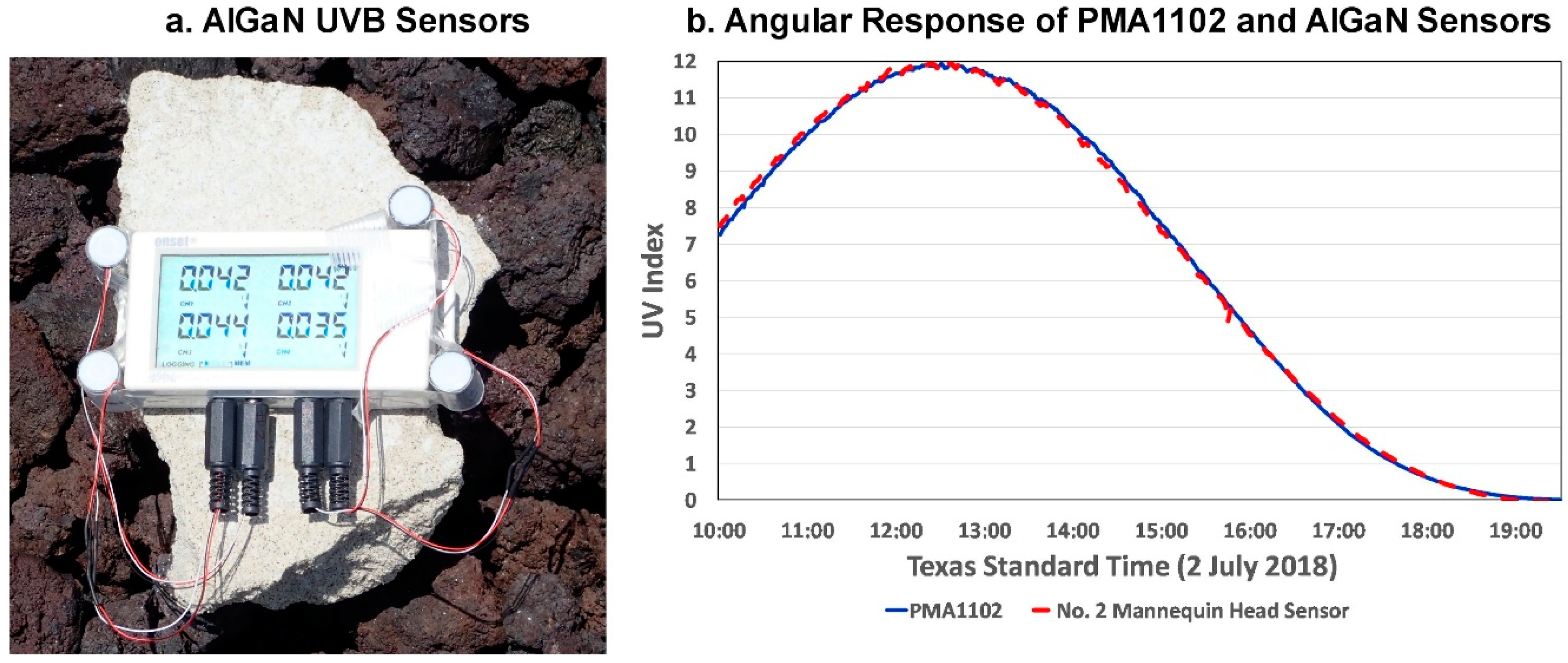
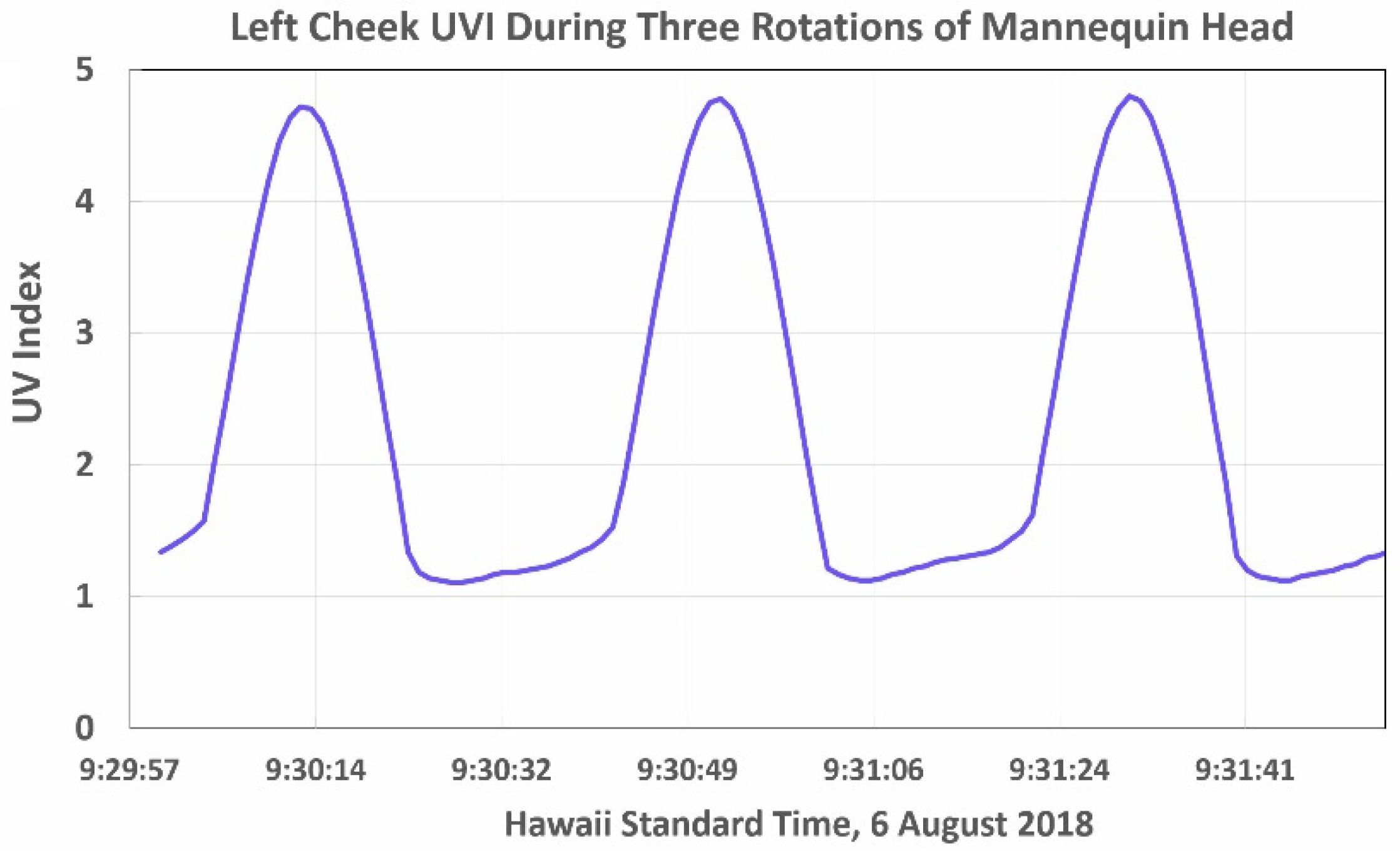



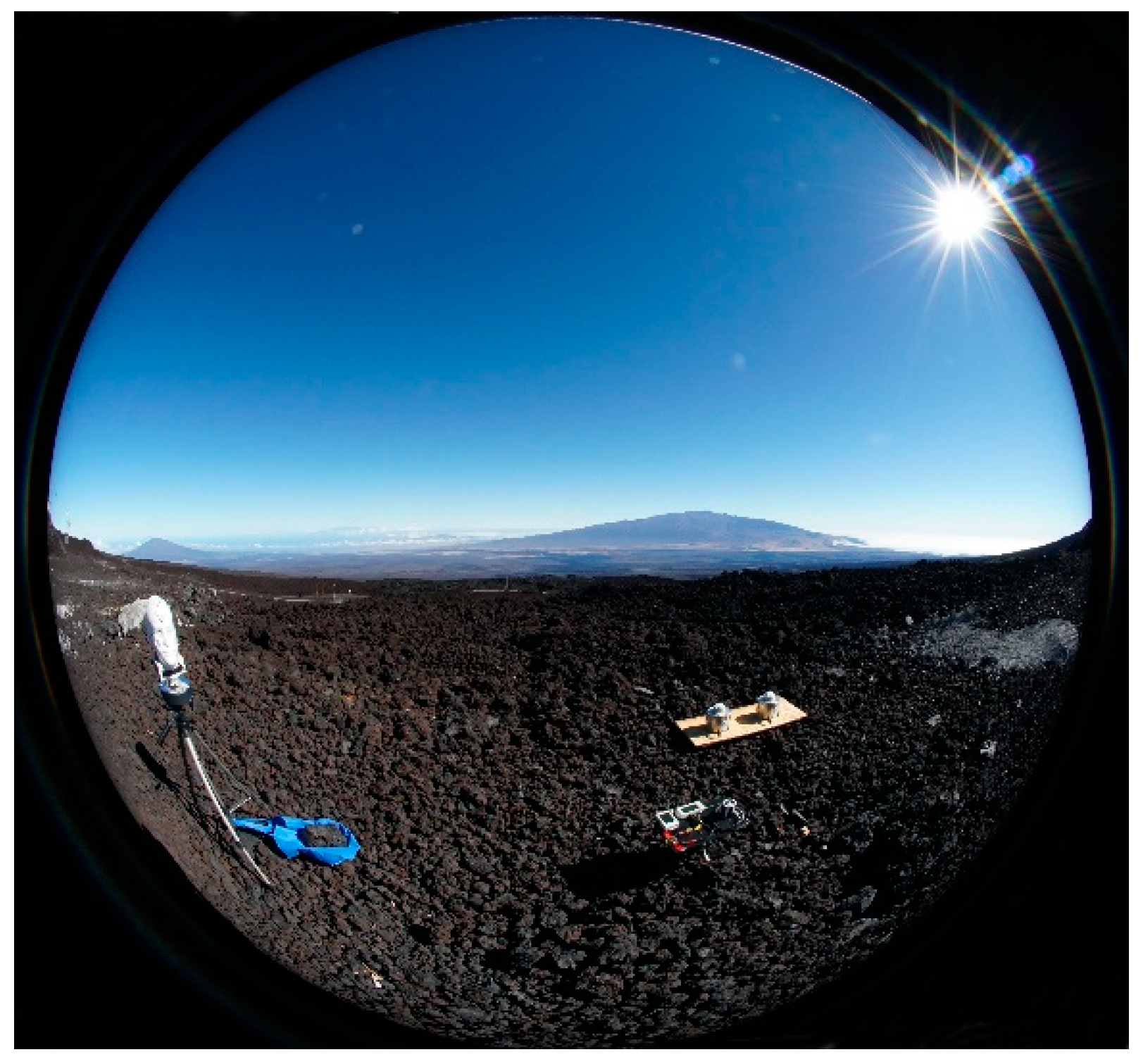

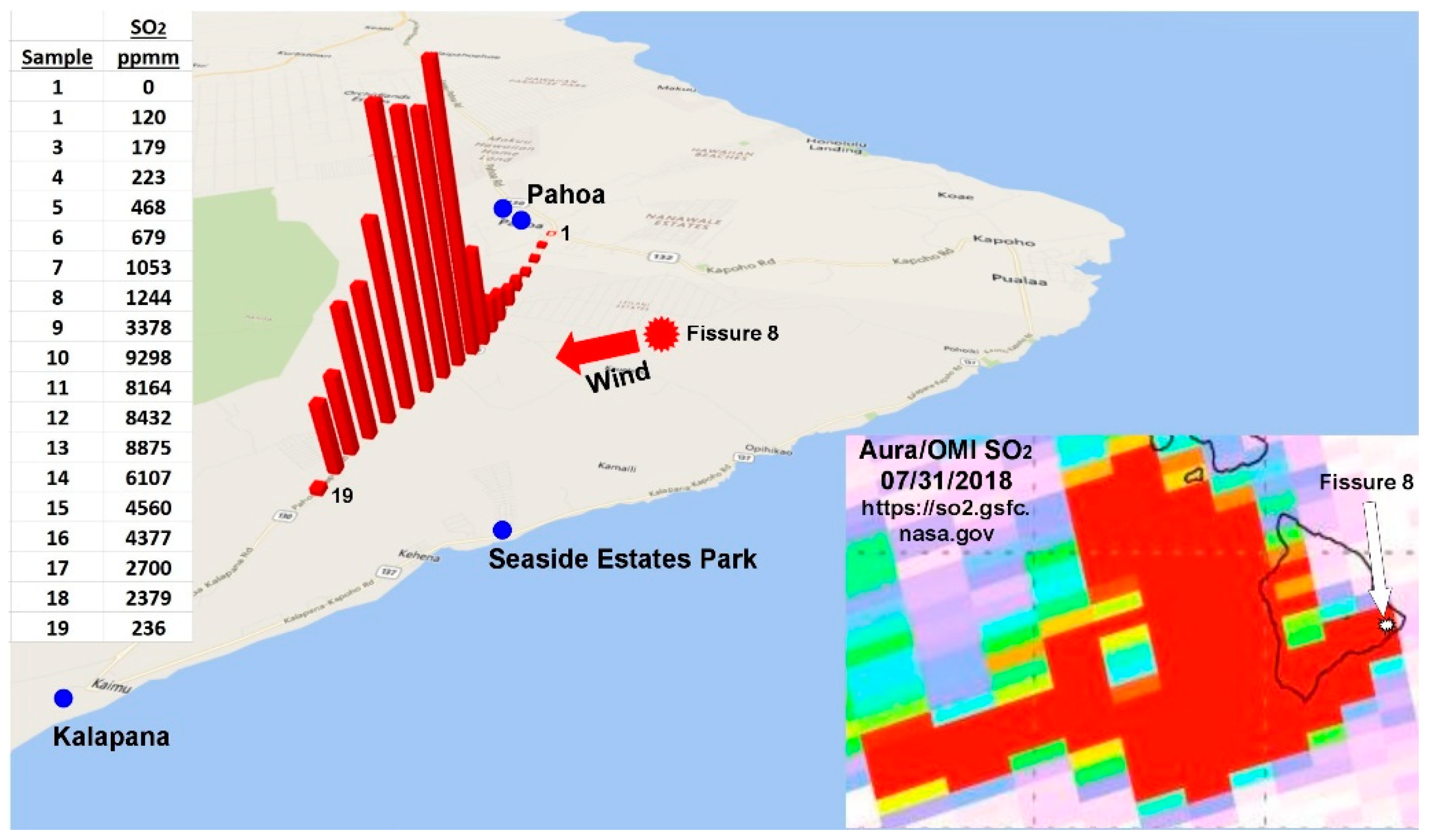
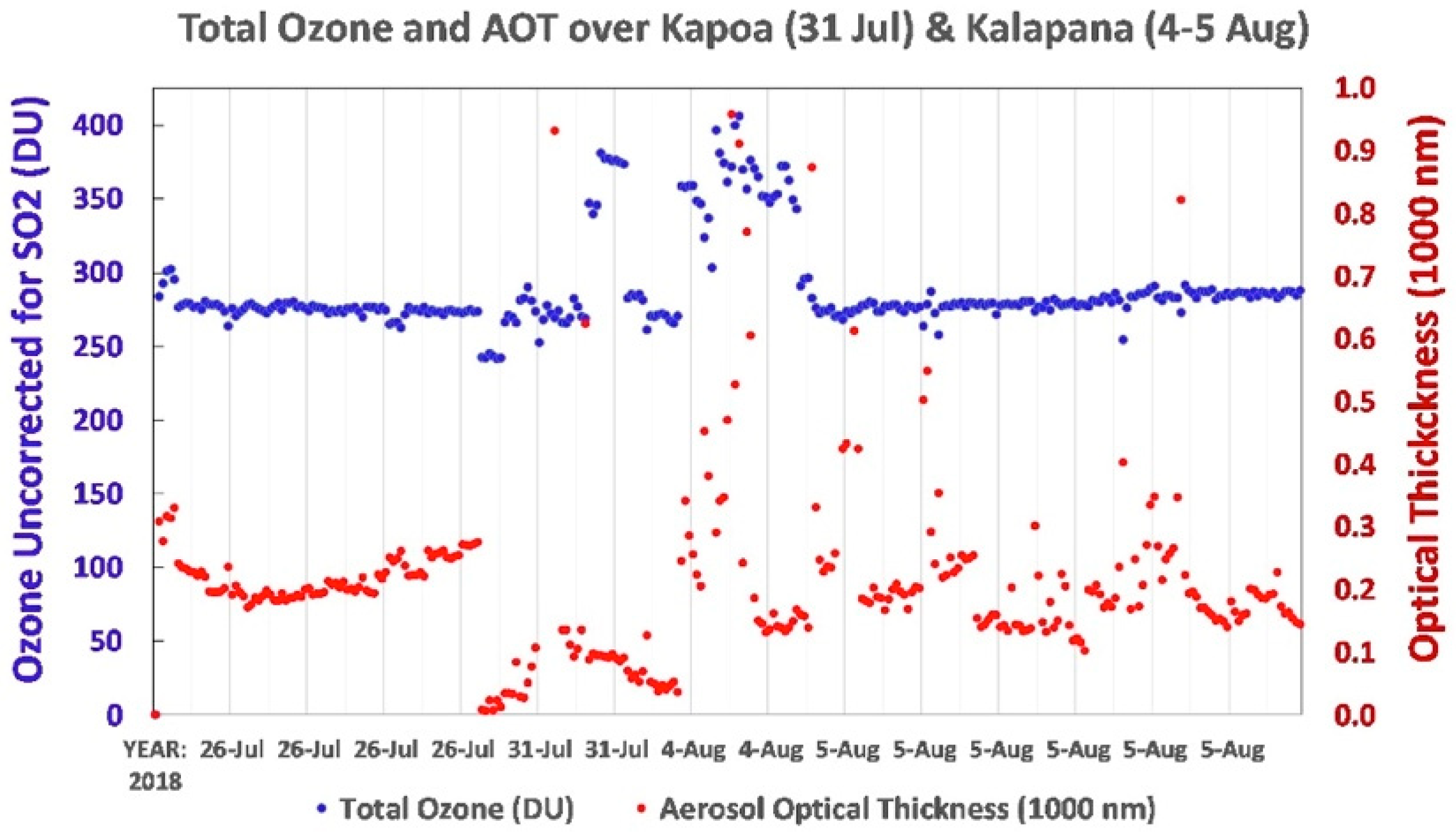
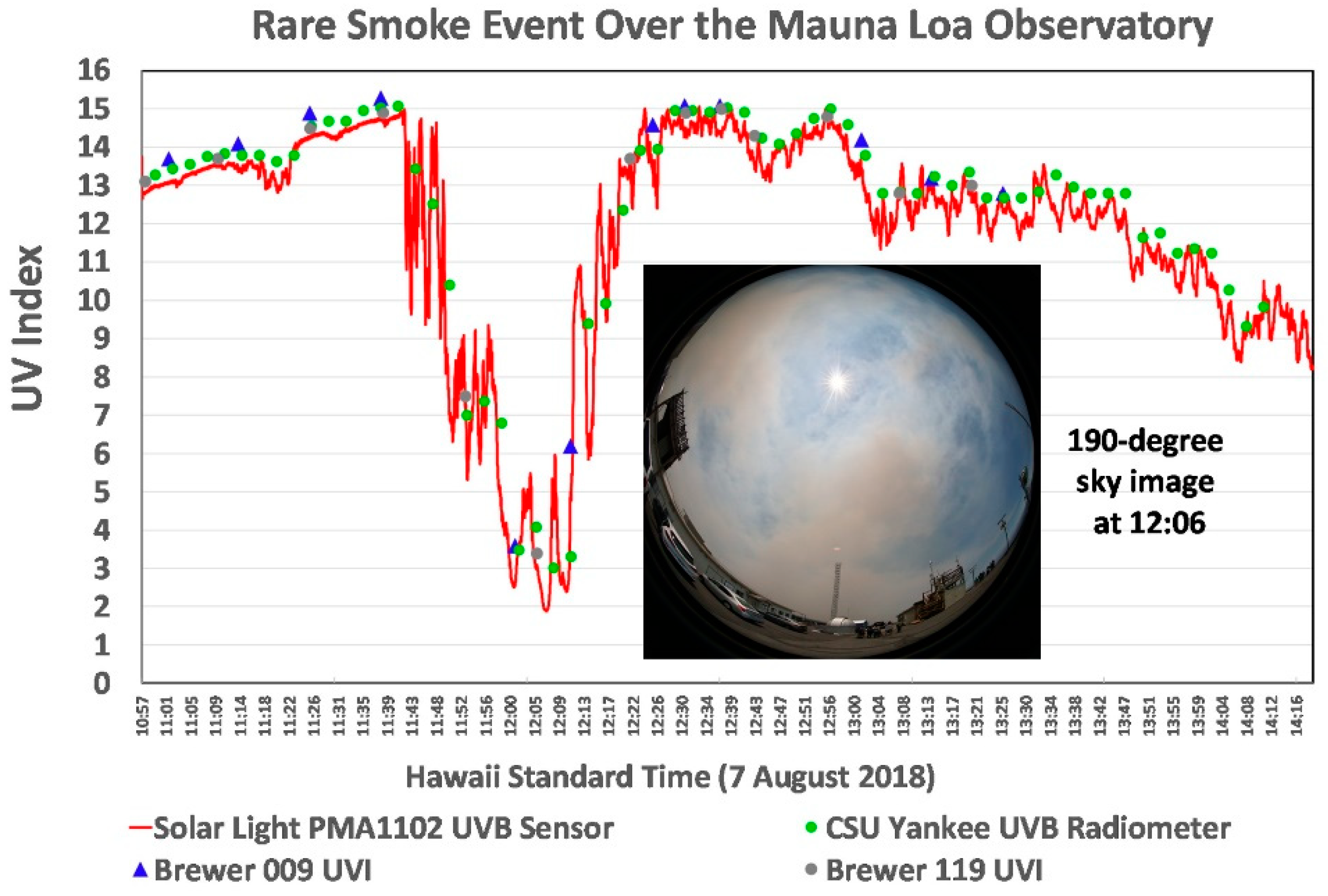


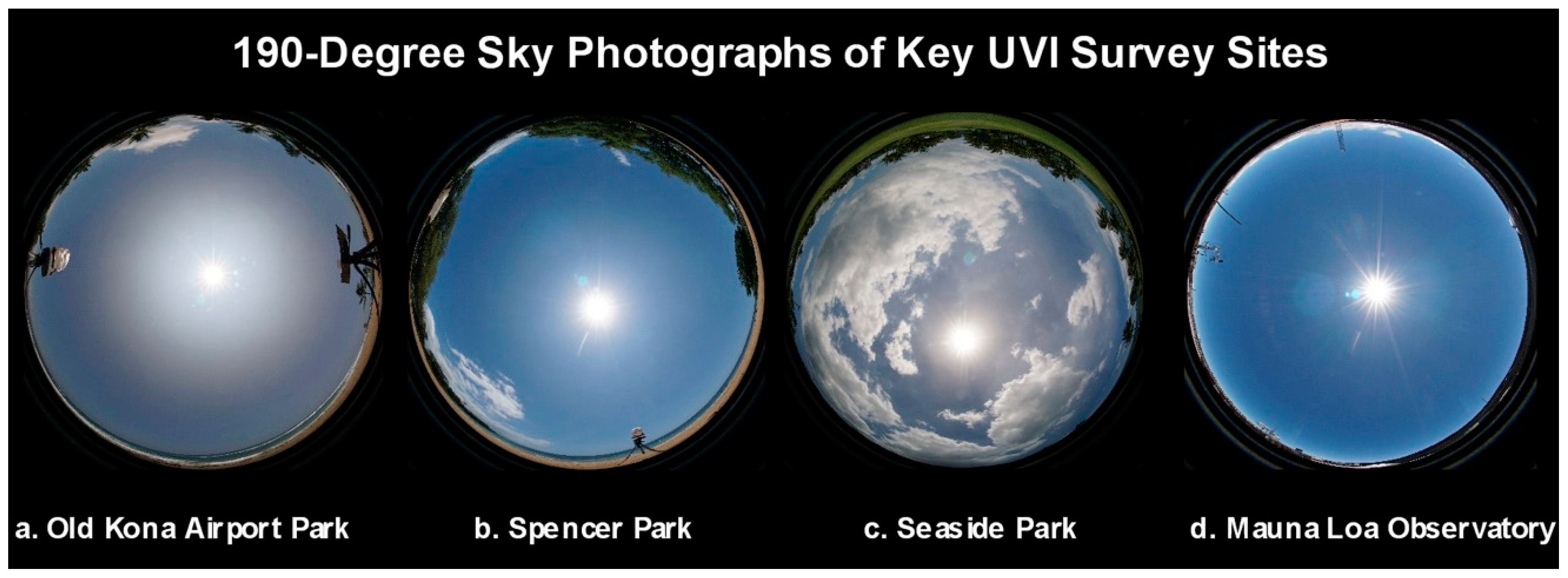





| Site | Lat° | Lon° | Elev (m) | Comments |
|---|---|---|---|---|
| MLO (mannequin) | 19.537 | −155.575 | 3389 | Ideal. Helicopter landing zone. |
| MLO (Solar Deck) | 19.536 | −155.576 | 3401 | Ideal. MLO UVR and ozone instruments. |
| Hilo Concrete Pier | 19.727 | −155.070 | 3 | Ideal sea level site (trees 47 m). |
| Old Kona Airport | 19.644 | −156.011 | 0 | Good sea level site (coconut palm 26 m). |
| Spencer Park Beach | 20.024 | −155.823 | 0 | Good sea level site (tree 32 m). |
| Seaview Estates Park | 19.399 | −154.920 | 26 | Good (coconut grove 40 m). |
| Akaka Falls | 19.856 | −155.152 | 335 | Fair. Low trees and hundreds of tourists. |
| Kalapana | 19.362 | −154.967 | 7 | Poor (2 coconut palms 15 m). |
| Pahōa | 19.491 | −154.942 | 218 | Poor (1-story buildings and power line). |
| UVI Survey Instruments | Purpose |
| PMA1102 UVR Sensor | Measurements of UVI during mannequin head sessions |
| AlGaN Photodiode UVR Sensors | Measurements of UVI at face of mannequin head |
| Microtops II Ozonometer | Total ozone and optical depth |
| Custom UVR radiometer | Direct sun & diffuse sky UVR measurements |
| PiSpec Spectrometer | UVR absorption by SO2 in volcanic plume |
| Mauna Loa Observatory Instruments | |
| UVB-1 UVB Broadband Radiometer | UVI and cosine comparison for PMA1102 |
| 7-channel UV Shadowband Radiometer | UVR at 300, 305, 311, 317, 325, 332 & 368 nm |
| Brewer Spectrophotometers (009 & 119) | UVI comparison for PMA1102 and total ozone |
| Mannequin Sensor | Morning Peak UVI | Noon Peak UVI | Noon Minimum UVI |
|---|---|---|---|
| Left Cheek | 5.5 | 1.6 | 1.1 |
| Left Ear | 5.0 | 1.1 | 0.6 |
| Left Eye | 6.5 | 1.6 | 1.1 |
| Site | Global UVI | Morning Peak UVI | Noon Peak UVI | Noon Minimum UVI |
|---|---|---|---|---|
| Kona | 12.8 | 5.2 | 2.8 | 2.7 |
| MLO | 14.2 | 5.5 | 1.6 | 1.1 |
| Site | Noon SZA | Global UVI | Direct | Diffuse | Cheek UVI | Direct | Diffuse | Surface Reflectance UVR |
|---|---|---|---|---|---|---|---|---|
| Kona | 3.6° | 12.6 | 38% | 62% | 2.8 | -- | ~100% | Sand (5.9%) |
| MLO | 4.6° | 16 | 69% | 31% | 2.4 | -- | ~100% | Lava (20%) |
| Camera | Purpose |
|---|---|
| Olympus Tough water proof | Apparatus and general imagery |
| Canon G9 with sun occluder | Solar aureole imagery |
| Sony α6000 with 190° lens | Full sky imagery |
| Mi Sphere VR 360° | Full sphere imagery of the sky and surface |
| Custom UV camera | Color-coded images of UVR on the mannequin head |
© 2019 by the authors. Licensee MDPI, Basel, Switzerland. This article is an open access article distributed under the terms and conditions of the Creative Commons Attribution (CC BY) license (http://creativecommons.org/licenses/by/4.0/).
Share and Cite
Mims, F.M., III; McGonigle, A.J.S.; Wilkes, T.C.; Parisi, A.V.; Grant, W.B.; Cook, J.M.; Pering, T.D. Measuring and Visualizing Solar UV for a Wide Range of Atmospheric Conditions on Hawai’i Island. Int. J. Environ. Res. Public Health 2019, 16, 997. https://doi.org/10.3390/ijerph16060997
Mims FM III, McGonigle AJS, Wilkes TC, Parisi AV, Grant WB, Cook JM, Pering TD. Measuring and Visualizing Solar UV for a Wide Range of Atmospheric Conditions on Hawai’i Island. International Journal of Environmental Research and Public Health. 2019; 16(6):997. https://doi.org/10.3390/ijerph16060997
Chicago/Turabian StyleMims, Forrest M., III, Andrew J. S. McGonigle, Thomas C. Wilkes, Alfio V. Parisi, William B. Grant, Joseph M. Cook, and Tom D. Pering. 2019. "Measuring and Visualizing Solar UV for a Wide Range of Atmospheric Conditions on Hawai’i Island" International Journal of Environmental Research and Public Health 16, no. 6: 997. https://doi.org/10.3390/ijerph16060997
APA StyleMims, F. M., III, McGonigle, A. J. S., Wilkes, T. C., Parisi, A. V., Grant, W. B., Cook, J. M., & Pering, T. D. (2019). Measuring and Visualizing Solar UV for a Wide Range of Atmospheric Conditions on Hawai’i Island. International Journal of Environmental Research and Public Health, 16(6), 997. https://doi.org/10.3390/ijerph16060997







